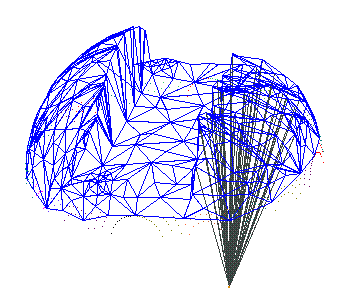

Introduction |
Methods for reconstructing from range images a surface of a three dimensional object have evolved rapidly in the last years. One reconstruction paradigm, known as a local deformation one, is to reshape dynamic and locally a geometrically simple, but closed mesh until it fits the range data with specified accuracy. To our knowledge, the proposed deformables algorithms until today, can only produce meshes which are topologically equivalent to the initial one.
Radial Flow Model (RFM) is a method of reconstruction of a surface from a unregistered range image that uses this deformable principle. It was created under the inspiration of the Chen and Medioni's work [1], by combining advantages of its and of a function graph-model [2],. However, it overcomes their limitations such as self-intersections, restriction to surfaces with number of genus zero in the first approach and cracks in the reconstructed surfaces in the second approach. RFM generates a 3D closed mesh without holes, without self-intersections and without restriction to topological class of the surface to be reconstructed.
The basic principle of RFM is simple, it starts by making a radial
mapping of the vertices of a decahedron to sampled points, and as they
grow towards their corresponding points, growing mesh is refined
by genering new vertices and new radial mappings until that the mesh gradually
adjusts in the range image. In order to maintain the topological consistency
between the surface sampled and surface reconstructed, the topological
genus estimated from range image is reflected on the mesh during the growing.
The method |
From the range data the initial reference system is determined and an
initial closed mesh (decahedron) is placed on the origin of this reference
system. Under the influence of a radial force, the mesh inflates as its
vertices move towards the corresponding points in the range image. When
the length of an edge in the mesh is greater than a specified tolerance,
the edge is subdivided and the mesh must be refined maintain a triangular
topology.
The sequence of operations refining-inflating is repeated, until no
more subdivision and no more inflation is possible. Then, reconstruction
errors are evaluated. If there are no faces in the mesh i with reconstruction
errors, we consider that the aimed reconstructed 3D model is achieved.
Otherwise, the
triangular faces that still have reconstruction errors are grouped
into disjoint sets of faces. These sets of faces are denoted fronts (of
growth). From each of them we determine a new radial reference system before
carrying out again the cyclic sequence refine-inflating to yield a new
mesh i+1.
Moreover, whatever the surface to be reconstructed presents genus number different from zero, our method is able to realize topological surgeries during the deformation process in order to match the topology of the deformable model with the topology of the reconstructed surface.
Some reconstructed surfaces with their respective range images are showed
now
Implementation |
Radial Flow Model has been implemented in language C in the platform
UNIX. It is executable in SUN-SPARC and PC (Linux).
For visualization of reconstructed surfaces have been used the grafic
library MESA (clone freeware of grafic interface OpenGL) and the grafic
package Geomview.
The implementation so depends on a topological structure management
library, TDM [1], written by Prof. Ting.